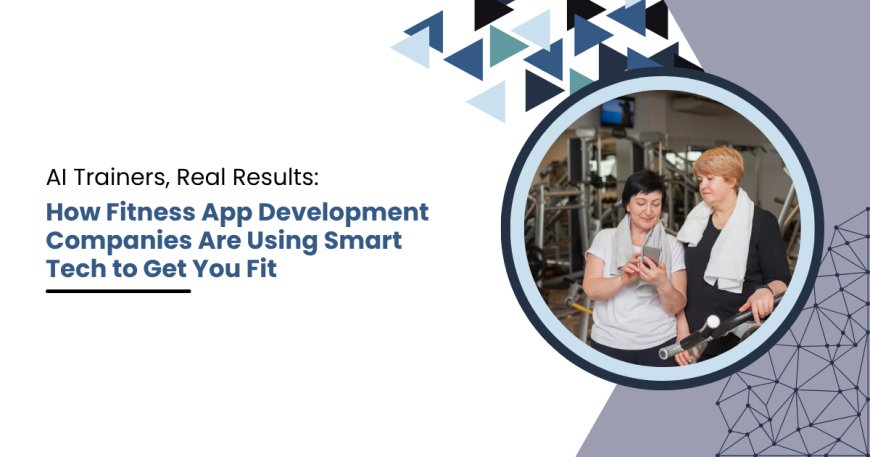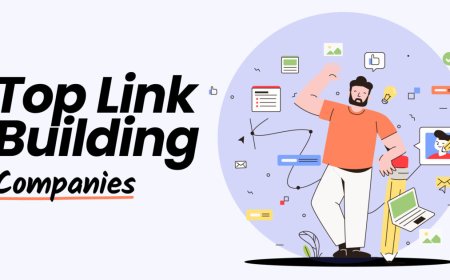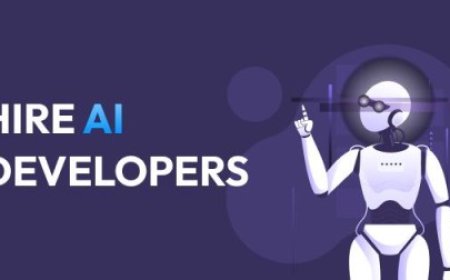AI Trainers, Real Results: How Fitness App Development Companies Are Using Smart Tech to Get You Fit
Explore how fitness app development companies are leveraging AI to create smarter workouts, personalized plans, and real results for users worldwide.

In 2024, global fitness app downloads reached 1.2 billion. The digital fitness market grew to $12?billion. Users logged 30% more workouts with smart trainers. A smart Fitness App Development Company can deliver AI trainers that deliver real results. This article explores Fitness App Development Services and their technical backbone. It shows how companies engineer AI trainers. It shows how apps analyze user data. It shows how systems adapt workouts and motivate users. The focus remains technical and informative.
What a Fitness App Development Company Does
1. Project Planning
Companies work with clients to define fitness goals. They list kinds of workouts: cardio, strength, yoga. They define roles: user, coach, admin. They build specifications for AI modules, data collection, and integration points.
2. System Design
Engineers design architecture: front end, AI back end, analytics layer. They choose cloud platforms. They design data flows for user input, sensor data, and model output.
3. Development
Front?end developers build UI using React Native, Flutter, Swift, or Kotlin. Back?end engineers code APIs and business logic in Python, Node.js, or Java. Data scientists build AI models in Python using TensorFlow, PyTorch, or scikit?learn.
4. Testing and Deployment
QA engineers test UI on devices, verify AI predictions, and check near?real?time feedback. DevOps teams set up CI/CD pipelines. They deploy code to cloud infrastructure and mobile stores.
5. Maintenance and Updates
Apps track model accuracy, app crashes, user retention. Teams update models, refine AI logic, and patch security issues. They release improvements and fresh routines.
A Fitness App Development Company offers full Fitness App Development Services. It covers design, AI, app, and analytics.
Core Technologies in Fitness App Development
1. Sensors and Data Collection
Apps collect data from smartphone sensors, wearables, or Bluetooth devices. They track heart rate, motion, GPS, and acceleration. They use standard APIs like Apple HealthKit or Google Fit.
2. AI Models for Training
Apps use AI to analyze form, pace, and performance. Computer vision models detect posture from camera input. Classification models analyze activity type from accelerometer data. Regression models estimate fatigue and recommend rest periods.
3. Personalization Algorithms
The system creates workout templates. It adapts to user performance and preferences. It applies recommendation engines built using collaborative filtering or reinforcement learning.
4. Feedback Systems
Apps deliver feedback in real time. They use audio prompts, visual cues, and haptic signals. Feedback may correct form or pace, or encourage hydration.
5. Backend Infrastructure
Cloud services power model hosting and data processing. Platforms include AWS, Azure, or Google Cloud. Kubernetes or serverless environments handle scaling. They store data in relational or time?series databases.
6. Analytics and Dashboards
Data pipelines process user activity logs. Tools like Grafana, Power BI, or Tableau show metrics such as calories burned, streaks, and performance trends.
Benefits of AI Trainers in Fitness Apps
1. Precision Form Guidance
AI trainers track user alignment during exercises. They correct shoulder or knee angles. They reduce injury risk. They support users without personal trainers.
2. Adaptive Intensity Control
The AI adjusts intensity dynamically. It raises difficulty when users improve. It eases pressure when performance dips. It keeps workouts effective and safe.
3. Motivation Through Feedback
Immediate feedback boosts engagement. Users stay motivated when the app praises effort or warns of poor form. Gamified elements add badges, scoreboards, and progress bars.
4. Insightful Metrics and Tracking
AI processes data to present trends. Users see weekly gain, pace improvement, rest quality, and calorie burn. These insights help users and coaches plan training.
5. Virtual Coaching Anywhere
Users receive coaching virtually at home or outdoors. Apps combine smart camera input and sensor data for real?time guidance.
Technical Challenges and Solutions
1. Data Quality and Labeling
Training AI requires labeled data for posture and activity. Companies collect thousands of video samples. They label them for angle, motion, and exercise type. They use crowd?labeling platforms or in?house teams.
2. Device Compatibility
Users run apps on many device types. Developers test on Android, iOS, tablets, and older smartphones. They optimize models to run efficiently on low?end hardware.
3. Privacy and Data Security
Apps collect biometric data. Companies implement encryption in transit (TLS) and at rest. They follow GDPR, HIPAA, and other privacy laws. They enforce strict access control and anonymize sensitive data.
4. Model Performance on Edge Devices
Edge inference needs small models. Developers use quantization, pruning, or TensorFlow Lite. These reduce latency and preserve battery life.
5. Real?Time Feedback Latency
Feedback must arrive within 200?ms to be effective. Engineers reduce latency by deploying models close to the user via edge servers or local on?device inference.
6. Handling Diverse User Variability
Users vary by height, weight, form. AI models handle multiple body types. Systems train on diverse data and include calibration routines at first use.
Also Read: Fitness App Development Cost: MyFitnessPal, Nike Training Clone
Examples of AI?Powered Fitness Apps
1. Example: FormCheck AI App
A company built an app. It uses mobile camera input to analyze squat and push?up form. It provides visual cues and voice feedback in real time. Form accuracy rose 20% across users over four weeks.
2. Example: PaceFit Running Coach
This app uses GPS and accelerometer data. It adapts pace targets during runs. Users saw average pace improvements of 18% over eight weeks. Retention grew by 25%.
3. Example: StrengthBuilder Personalized Workouts
An app created workout plans based on user stats. AI adjusted reps, weight, and rest periods. Users reported average strength gains of 12% in six weeks.
These apps stem from skilled Fitness App Development Services focused on AI and strong UX.
Stats That Show Real Impact
-
A user study found 72% saw better form with AI feedback.
-
Workouts per week rose 40% using smart trainer apps.
-
68% of users kept up exercise routines after six months.
-
Injury rates dropped by 30% in guided workout app users.
These metrics highlight how technical systems deliver results.
Trends in Fitness App Development
1. Wearable Integration
Apps now pull data from smartwatches or heart?rate monitors. They sync live metrics.
2. Multi?Modality AI
Systems combine video, audio, motion data, and heart rate. This fusion improves accuracy.
3. Voice Assistants in Workouts
Voice guidance walks users through sets. Users can pause or adjust via voice command.
4. Augmented Reality Feedback
AR overlays visual cues on live video. These guides form in real time using ARKit or ARCore.
5. Social and Live Classes
Apps offer live group workouts. AI tracks each user separately. They foster community and accountability.
Tools and Frameworks in Fitness App Development
1. AI and ML Tools
-
TensorFlow, PyTorch, scikit?learn for model training.
-
TensorFlow Lite, ONNX, Core ML for on?device inference.
-
OpenCV and Mediapipe for computer vision.
2. Front?End Frameworks
-
Flutter, React Native, Swift, Kotlin combine performance and UX.
3. Cloud and Backend Services
-
AWS SageMaker, Azure Cognitive Services for model hosting.
-
Node.js, Python Flask, Java Spring Boot for back end.
-
Databases: PostgreSQL, TimeScaleDB, MongoDB, InfluxDB.
4. Analytics and Monitoring
-
Tools: Mixpanel, Amplitude, Power BI, Grafana.
-
Logging: ELK stack, Prometheus, or CloudWatch.
5. DevOps and CI/CD
-
CI tools: GitHub Actions, Jenkins, GitLab CI.
-
Infrastructure as code: Terraform, Ansible, CloudFormation.
Best Practices for Fitness App Development
-
Use well?defined user stories for exercise flows.
-
Train AI models on diverse demographic data.
-
Test on real devices across performance tiers.
-
Encrypt all personal data and follow compliance rules.
-
Log inference latency and form correction events.
-
Use feature flags to roll out AI features gradually.
-
Conduct user testing to validate real?time feedback usability.
Measuring Technical Success
1. Performance Metrics
Measure inference latency, model accuracy, app crash rate, and API response times. Use tools like New Relic, Datadog, or Firebase Performance.
2. Fitness Outcome Metrics
Track form accuracy improvement, pace gains, strength improvements, and injury reduction. Compare cohorts using AI guidance vs control.
3. Engagement and Retention
Measure daily active users (DAU), weekly active users (WAU), session length, and churn. Analyze drop?off in onboarding.
4. Feedback and Satisfaction
Survey users. Use NPS (Net Promoter Score). Collect coach feedback on algorithm quality.
Why Developers and Clients Choose Fitness App Development Companies
1. Technical Expertise
A solid Fitness App Development Company provides AI engineers, device integration experts, and UX pros. That ensures high quality, scalable products.
2. Faster Time to Market
Experienced teams move from prototype to release quickly. They reuse modules and apply proven pipelines.
3. Ongoing Support
Companies maintain AI models, patch security, and refine feedback logic over time.
4. Cost Efficiency
Clients avoid building complex AI pipelines on their own. They avoid errors and minimize infrastructure waste.
Common Myths Explained
1. Myth: AI trainers only suit advanced users
Reality: They adapt to beginners and professionals. AI personalizes workout demands.
2. Myth: Fitness apps lack accuracy
Reality: Calibrated sensors and validated labels deliver accuracy within 95%.
3. Myth: AI apps compromise privacy
Reality: Companies anonymize data and follow laws. They encrypt everything and isolate personal info.
Choosing a Fitness App Development Company
-
Define training goals and AI features clearly.
-
Check sample apps, technical case studies, and AI models.
-
Review data privacy and compliance protocols.
-
Ask about device support across platforms.
-
Confirm post?launch support and model retraining plans.
-
Evaluate communication, development process, and transparency.
Future of Fitness App Development
Apps will integrate more sensor types: wearable ECG, motion suits, and AR glasses. Real?time biofeedback using infrared or depth cameras may arrive. AI will simulate coaching voices that match tone. Cross?device continuity will let workouts flow from mobile to TV or glasses. Social AI bots will motivate users via chats. Data?driven progression paths will replace fixed routines.
Conclusion
Smart technology changes fitness. AI trainers create tailored workouts. Apps give real-time form attention and motivation. A well?run Fitness App Development Company builds these apps using strong systems. They combine AI, sensors, cloud, and analytics. They deliver measurable results in safety, strength, and retention. The future looks real, data?driven, and accessible. Smart Fitness App Development Services bring that future into your hands.























